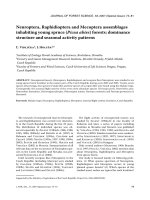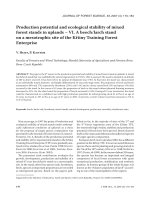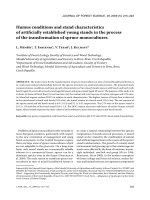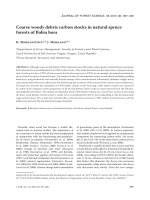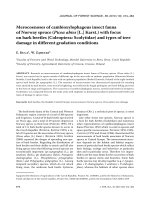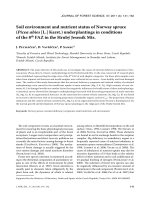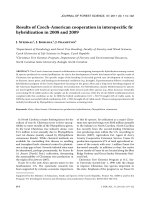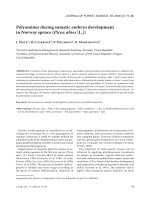Báo cáo lâm nghiệp: " Nutritive stress and cytokinin status in Norway spruce seedlings (Picea abies L. Karst.)" ppsx
Bạn đang xem bản rút gọn của tài liệu. Xem và tải ngay bản đầy đủ của tài liệu tại đây (124.67 KB, 5 trang )
449
Ann. For. Sci. 62 (2005) 449–453
© INRA, EDP Sciences, 2005
DOI: 10.1051/forest:2005041
Original article
Nutritive stress and cytokinin status in Norway spruce seedlings
(Picea abies L. Karst.)
Klaus v. SCHWARTZENBERG*, Heinz HAHN
Biozentrum Klein Flottbek und Botanischer Garten, University Hamburg, Ohnhorststr. 18, 22609 Hamburg, Germany
(Received 29 March 2004; accepted 14 March 2005)
Abstract – The content of cytokinins was analysed in shoots and roots from spruce seedlings (Picea abies L. Karst.) grown on various
hydroculture media either with complete nutrient supply (control medium) or with deficiencies for some nutrients (stress medium). The
cytokinins zeatin riboside and isopentenyladenosine were determined by an indirect competitive enzyme-linked immunosorbent assay (ELISA)
in HPLC-purified extracts. The shoots of spruce seedlings grown on stress medium plus aluminum ions (Al
3+
, 0.8 mM) showed approximately
5-fold higher concentration of zeatin riboside and isopentenyladenosine than the controls. When the auxin naphtylacetic acid (1 µM) was added
to the stress medium, also higher levels of cytokinin ribosides were measured in the shoots. In the roots however, cytokinin riboside levels did
not increase significantly, neither under Al
3+
nor auxin treatment. The model experiments with spruce seedlings grown under controlled
conditions support previous monitoring data on declining forest stands and show that nutritive stress can significantly increase the cytokinin
content in the shoot of Norway spruce.
cytokinin / forest decline / nutrient deficiency / Norway spruce / Picea abies
Résumé – Stress nutritionnel et teneur en cytokinines chez des semis d’épicéa. Le contenu en cytokinines des parties aériennes et racinaires
de jeunes semis d’épicéas (Picea abies) élevés en culture hydroponique sur différents milieux a été étudié. Il s’agissait soit de milieux
comportant tous les éléments nutritifs (témoin), soit de milieux déficients en certains nutriments (stress). Le contenu en cytokinines (zéatine
riboside et isopentényladénosine) a été déterminé à l’aide de la méthode d’inhibition compétitive (ELISA) sur des extraits purifiés par HPLC.
Les pousses de semis élevés sur milieu « stressant » contenant des ions aluminium (Al
3+
, 0,8 mM) présentent une concentration en ces deux
cytokinines environ cinq fois plus élevée que celle des plants témoins. Lorsque l’auxine, acide naphtylacétique (1 µM), est ajoutée au milieu
« stressant », on constate aussi des niveaux plus élevés de ces ribosides de cytokinines dans la partie aérienne. Par contre dans la partie racinaire,
ces derniers n’augmentent pas significativement, que ce soit en présence d’Al
3+
ou d’auxine. Cet essai sur semis en conditions contrôlées
confirme des résultats précédents portant sur des peuplements d’épicéas dépérissant. Cela montre qu’un stress nutritif peut augmenter
significativement le contenu en cytokinines des pousses d’épicéa commun.
cytokinine / dépérissement forestier / déficit nutritionnel / épicéa commun / Picea abies
Abbreviations: Equ.: equivalents, dw: dry weight, [9R]iP: isopentenyladenosine, NAA: naphtyl acetic acid, [9R]Z: zeatin riboside.
1. INTRODUCTION
Trees of Norway spruce suffering of symptoms of forest
decline very often show early senescence, needle loss, changes
in annual ring width or changes in root morphology [1, 10].
For plant hormones like cytokinins it has been demonstrated
that they are involved in some of these developmental proc-
esses, e.g., root growth or senescence [8, 13]. For model plants
the importance of cytokinins for the development was corrob-
orated by transgene overexpression studies using the cytokinin
biosynthetic gene isopentenyltransferase (ipt) [6, 22] or the
cytokinin degradation gene cytokinin oxidase (ckx) [9, 24]. The
ipt-overexpression leads to a strong increase of the endogenous
cytokinin content resulting in plants with enhanced budding
and a strongly reduced root growth. The ckx-overexpression
leads to cytokinin deficiency and in consequence the activity
of the vegetative and floral shoot apical meristems and leaf pri-
mordia was diminished. On the root level however, the activity
of the meristem was enhanced leading to stronger root growth
[24].
With respect to forest decline and tree damage it was dis-
cussed that the symptoms of environmentally stressed trees
might be related to an altered status of plant hormones [4, 16,
17]. A correlation of tree damage and alterations in cytokinin
* Corresponding author:
Article published by EDP Sciences and available at or />450 K. v. Schwartzenberg, H. Hahn
status was demonstrated for declining Norway spruce trees
from forest stands, which showed significantly increased levels
of the cytokinin ribosides isopentenyladenosine and zeatin
riboside in needles [19, 21]. These works have also shown that
the level of cytokinin ribosides in the needles was correlated
with the nutritional status of the spruce trees. In a forest stand
affected by atmosphere derived acid deposition young declin-
ing spruce trees (approx. 15 years old) showing chlorosis and
needle loss had a strongly elevated needle content of cytokinin
ribosides when compared to neighbouring trees having
received fertilisation and liming and showed consequently a
low degree of needle loss and chlorosis. For Sitka spruce trees
Collier and co-workers found that mature trees sprayed with
different combinations of N had elevated cytokinin levels in
their needles [5]. These authors concluded that the cytokinin
content might be used as a sensitive bioindicator of N pollution
in Sitka spruce. Also Kraigher and Hanke [15] have shown in
field experiments, that the determination of cytokinin ribosides
in Norway spruce seedlings has a potential for monitoring soil
born stress.
It is obvious that under forest conditions it is difficult to
assess the relationship between altered hormonal status and
developmental changes or tree vitality because of the complex-
ity of environmental factors. In this work we therefore used
controlled conditions in order to address the question how the
level of endogenous cytokinins might be affected in declining
trees suffering from nutritive stress. We used Norway spruce
seedlings growing on hydroculture media with different com-
position as an easy to handle system. In order to mimic the sit-
uation in a stressed forest stand we chose a synthetic medium
composed according to the mineral analysis of a soil solution
collected from a forest stand suffering from acidic deposition
and nutrient shortage as published in [12]. In this work Junga
proposes a hypothesis of disturbed hormonal balance for spruce
under nutritive stress based on the observation that acidic con-
ditions in combination with phytotoxic Al
3+
ions damage the
root primary meristems as a site of cytokinin biosynthesis. The
consequently reduced cytokinin biosynthesis is thought to lead
to a higher auxin/cytokinin ratio in the root, thus inducing the
formation of secondary roots. The increased number of root
meristems is then proposed to be responsible for an elevated
export of cytokinins to the shoot, where cytokinin promoted
effects could then cause an increased flux of auxin from the
shoot to the root. As this hypothesis seems compatible with the
finding of increased levels of cytokinins in needles of damaged
spruce, we attempt to further analyse the question, whether a
hormonal disequilibrium in the root of stressed trees can affect
cytokinin levels in the shoot by administering either AlCl
3
or
the synthetic auxin naphtyl acetic acid. Results are discussed
with respect to the suitability of spruce seedlings as a model
system to investigate physiological consequences of soil acid-
ification.
2. MATERIAL AND METHODS
2.1. Hydroculture of spruce seedlings
In order to check under laboratory conditions, whether nutritive
stress has an impact on the cytokinin status, seeds of Norway spruce
Picea abies L. Karst. (Staatsklenge Nagold, Herkunft 84008, Forstamt
Enzklösterle) were spread out on sterile water agar (1%) for germina-
tion at 20 °C. Three weeks after germination seedlings without visible
microbial infection were selected and transferred to hydroculture
according to Junga [12]. For hydroculture we used glass beakers (2 L,
diameter 13 cm), in which 35 seedlings were fixed with V2A-steel nets
(wire diameter 0.56 mm, mesh width 4 mm). The net was fixed in
10 cm height above the bottom of the vessel, which was covered with
the lid of a petridish (diameter 14 cm). The vessels were autoclaved
(120 °C, 30 min) and their bottom part was darkened with black paper.
Per culture vessel 1.5 L of sterile culture medium were used. Cultures
with visible microbial infections were discarded. We considered the
culture system as semi-sterile, no further sterility tests were carried out.
A CONTROL medium according to Ingestad was chosen as it is
based on the mineral content determined in spruce plants and therefore
provides an equilibrated nutrient supply, see [11, 12]. The basal
STRESS medium, was composed according to the soil solution of a
declining spruce forest stand (BLF-medium, [12]) and contained
lower amounts of nutrients, especially calcium and magnesium
(Tab. I). In one set of STRESS-cultures AlCl
3
(0.8 mM) was added
to the medium. For Al
3+
-ions it is known that they have phytotoxic
effects on roots (e.g., [7, 14, 16]). In corresponding STRESS treat-
ments without Al
3+
, the concentration of the Cl
–
counter ions was
maintained equal to the AlCl
3
treatment by supplementing the culture
medium with 2.4 mM NaCl.
In another set of STRESS-cultures the hormonal balance of the
seedlings was altered by the addition of naphtyl acetic acid (NAA) as
a synthetic auxin.
For the first 4 weeks all seedlings were cultivated on CONTROL
medium at pH 5.8 (Tab. I, according to [12]). In order to expose the
plants to different nutrient supply, parts of the seedlings were trans-
ferred to STRESS media with a reduced nutrient content (Tab. I).
Tab le I. Composition of basal media used for the growth of Norway
spruce seedlings (according to Junga [12]). Basal media were used at
different pH or with additives, see Table II.
CONTROL
(mmol/L)
STRESS
(mmol/L)
NH
4
HSO
4
– 0.238
NaNO
3
– 0.099
KNO
3
– 0.123
NH
4
NO
3
1.77 0.0762
FeSO
4
– 0.0197
FeCl
3
0.018 –
KCl 0.95 –
MgSO
4
0.61 0.04
MnSO
4
0.3 × 10
–3
0.0236
CaCl
2
10.14
K
2
HPO
4
– 0.0161
KH
2
PO
4
0.32 –
H
2
SO
4
–0.12
H
3
BO
3
16 × 10
–3
13.9 × 10
–3
ZnSO
4
0.63 × 10
–3
9.96 × 10
–3
CuSO
4
0.32 × 10
–3
0.0160 × 10
–3
Na
2
MoO
4
0.033 × 10
–3
0.165 × 10
–3
KI – 0.722 × 10
–3
CoSO
4
– 0.019 × 10
–3
NaCl 0.205 –
Nutritive stress and cytokinin status 451
Seedlings grown on STRESS medium to which either AlCl
3
, NaCl
(control for AlCl
3
treatment) or the synthetic NAA was added, were
compared to those grown on CONTROL medium as described in
Table II. Seedlings were cultivated on the various media, which were
replaced every 4 weeks. The cultures were placed at 20 °C in constant
light with ca. 90 µE m
–2
s
–1
(Osram LW58/77 Fluora).
After 20 weeks the seedlings were harvested and the roots were cut
from the shoot. Samples were frozen in liquid nitrogen, freeze dried
and homogenized to a fine powder using an electric coffee mill. Until
cytokinin and chlorophyll extraction the samples were stored at –20 °C.
2.2. Cytokinin extraction and determination
Samples of shoots (needles and stem) or roots were extracted
according to the method described in [20]. The powder of roots or
shoots (ca. 100 mg) was extracted in methanol at 58 °C for 15 min.
Extraction was continued for another 30 min at 4 °C. Cell debris was
sedimented by centrifugation for 10 min at 500× g. The supernatant
was adjusted to a methanol concentration of 80% by addition of dis-
tilled water and was then filtered through a glass fibre filter (Schleicher
und Schüll, No. 6) and a cellulose acetate filter (pore width 0.45 µm,
Sartorius Göttingen, Germany). The extract was passed through a Sep-
Pak C18 Cartridge (Millipore, Eschborn, Germany). The cytokinin
containing effluent was evaporated to dryness by a rotary evaporator
and taken up in 500 µL of 35% methanol (v/v). The samples were
submitted to preparative HPLC and the fractions containing zeatin
riboside and isopentenyladenosine were collected [19]. Cytokinin
ribosides were determined by an indirect competitive ELISA (enzyme-
linked immunosorbent assay) according to [19]. Per treatment (2 cul-
tures) 4 extracts were prepared and separated by HPLC. For measuring
cytokinins in the HPLC effluents 16 ELISA determinations per treat-
ment were performed from which the mean values and standard devi-
ation were calculated. Results were corrected for recovery losses by
multiplication with 1.25 and are expressed as equivalents of zeatin
riboside or isopentenyladenosine. The validation of the HPLC-ELISA
based method for cytokinin determination in spruce (including anti-
body specificities, recovery rates and standard addition curves) was
previously published [19, 20].
2.3. Chlorophyll determination
Chlorophyll was extracted from the shoot material with 85% aceton
(v/v). After elimination of cell debris by centrifugation (1000 × g,
120 min) the content of chlorophyll a and b was determined according
to the method described in [18].
3. RESULTS AND DISCUSSION
3.1. Reactions of spruce seedlings to different nutrient
supply
We cultivated spruce seedlings in hydroculture using media
with different nutrient composition as previously published by
Junga [12] (Tabs. I, II).
The biomass production was lower for the seedlings grown
on STRESS-pH 3.8 when compared to the CONTROLs
(Fig. 1A). Although biomass production of STRESS-pH 5.8
grown seedlings was only slightly reduced, the chlorophyll
measurements clearly showed a reduction of needle pigments
for all cultures grown on STRESS media. For the STRESS-
AlCl
3
and NAA variants the chlorophyll content was 4 and
5-fold lower compared to the controls confirming the observation
of a strong needle chlorosis of the seedlings (Fig. 1B, Tab. III).
Although no clear-cut effect could be seen with respect to
the shoot/root ratio, a major difference between the CONTROL
and the STRESS plants was found in the frequency of lateral
roots (Tab. III). CONTROL plants showed only few lateral
roots which mostly emerged close to the hypocotyl. Seedlings
grown on STRESS media however, had an increased number
of lateral roots, which inserted also in the apical region of the
primary root. The strongest lateral root production was
observed for the seedlings treated with the auxin NAA.
3.2. Cytokinin ribosides in seedlings
Cytokinin analysis was restricted to zeatin riboside and iso-
pentenyladenosine as these compounds have been shown to
accumulate in the needles of damaged trees [21].
Table II. Variations of culture media for hydroculture of spruce seedlings.
Complete nutrient supply Reduced nutrient supply
CONTROL pH 5.8 CONTROL pH 3.8 STRESS NaCl
2.4 mM, pH 5.8
STRESS NaCl
2.4 mM, pH 3.8
STRESS AlCl
3
0.8 mM, pH 3.8
STRESS NAA
pH 3.8, 1 µM
Figure 1. Fresh and dry weights (A) of 27 week old Norway spruce
seedlings and chlorophyll content (B) in shoots (needles and stem
material) after growth on different hydroculture media (see Tab. I).
Mean values from 35 plants.
452 K. v. Schwartzenberg, H. Hahn
From Figures 2A and 2B it is obvious that in almost all shoot
samples the content of isopentenyladenosine is higher than the
content of the zeatin riboside.
Comparing the content of cytokinin ribosides in the roots of
the seedlings no significant differences could be measured for
the different treatments.
However, the shoots of all STRESS-grown seedlings
showed higher concentrations of zeatin riboside than the con-
trols (Fig. 2A). In two assays with STRESS medium NaCl was
added to the stress medium in order to serve as an additional
control for the AlC
3
-treatment. At the administered NaCl con-
centration (2.4 mM) we did not observe morphological effects
when compared to STRESS medium without NaCl (not
shown).
In the STRESS-pH 5.8 plants zeatin riboside tended to val-
ues only slightly above the corresponding CONTROL. Appar-
ently nutrient shortage at pH 5.8 did not strongly influence the
cytokinin riboside content. But for the STRESS-plants at
pH 3.8 the average zeatin riboside level was 2.7-fold above the
one of the CONTROL-pH 3.8 plants although the standard
deviation was high. Besides analytical variations the high
standard deviations between the ELISA measurements reflects
also biological variations between the cultures and the use of
clonal plant material would help to improve the precision in
future experiments.
It can be concluded, that acidic pH of the nutrient solution
alone is not responsible for the increase of zeatin riboside in
the shoot as for the CONTROL-pH 3.8 and -pH 5.8 plants the
contents were close to each other. The strongest increase was
measured when AlCl
3
or NAA were added to the STRESS-
medium. The mean values for zeatin riboside were about
5 times higher than for the controls.
The data obtained for isopentenyladenosine showed to a
great extent parallelism to the zeatin riboside data and thus con-
firmed the finding of highly elevated cytokinin riboside con-
tents in the shoots of seedlings cultivated on STRESS AlCl
3
and
STRESS NAA (Fig. 2B).
The synthetic reconstitution of the soil solution of an acid-
ified spruce forest stand (STRESS) allows the assumption that
under forest conditions nutrient shortage in combination with
acidity and Al
3+
ions might contribute to increased cytokinin
riboside contents in spruce needles. The results of this work are
in accordance with previous cytokinin measurements in declin-
ing spruce trees which also revealed higher levels of cytokinin
ribosides in combination with lowered chlorophyll levels when
compared to fertilized trees from the same forest stand [21].
Table III. Description of spruce seedlings grown for 27 weeks on different hydroculture media (see. Tab. II).
Needle chlorosis Root colour Number of lateral roots Insertion of lateral roots Shoot/root ratio
(FW/FW)
CONTROL
pH 5.8
–yellow/white(+) basal 4.9
CONTROL
pH 3.8
–yellow/white + basal 5.7
STRESS NaCl
pH 5.8
+ yellow/white ++ basal and apical 3.6
STRESS NaCl
pH 3.8
+ dark brown +++ mostly apical 7.0
STRESS AlCl
3
pH 3.8
++ dark brown ++++ mostly apical 6.9
STRESS NAA
pH 3.8
++ dark brown ++++ basal and apical n.d.
n.d. not determined, – not visible, + very low, ++++ very high, (intermediate levels indicated by ++ to +++).
Figure 2. Content of (A) zeatin riboside ([9R]Z) and (B) isopentenyl-
adenosine ([9R]iP) in shoots and roots of 27 week old Norway spruce
seedlings. Cytokinin extractions were carried out in duplicate per cul-
ture. Per variant 2 hydrocultures were analysed. Results are mean val-
ues and standard deviations of 16 ELISA measurements per treatment
(shown is one representative experiment out of 3).
Nutritive stress and cytokinin status 453
Junga [12] had put forward the hypothesis, that stress in the
rhizosphere could lead to a hormonal imbalance. The aim of the
NAA treatment was to investigate, whether an artificial
increase of auxin on the root level can induce changes of the
cytokinin content in the shoot.
In discussing the elevated content of cytokinin ribosides in
shoots of seedlings grown on STRESS-AlCl
3
– and STRESS-
NAA-medium, we assume that the increased number of lateral
roots (Tab. II) contributes to a higher cytokinin production in
the roots. For auxins it is well known that they induce lateral
root formation [2] and in the STRESS-NAA plants the hormo-
nal imbalance as generated by the addition of NAA leads to a
largely increased number of lateral roots. Although in the roots
themselves no significant increase of cytokinins was measured,
it is hypothesised that the increased number of root apical mer-
istems, which are sites of cytokinin biosynthesis [3], leads to
an increased amount of cytokinin ribosides transported from
the root to the shoot. The data obtained in the STRESS AlCl
3
and STRESS-NAA-medium are in agreement with Junga’s
hypothesis of an altered hormonal balance under soil borne
stress [12].
Schwartzenberg et al. [23] had shown that roots of seedlings
grown on STRESS-AlCl
3
medium under hydroponic condi-
tions showed a clear reduction in the rate of metabolisation of
isopentenlyadenosine. We assume that the increased cytokinin
levels in shoots of stressed seedlings could in addition to the
increased number of root meristems result from metabolic fine
tuning processes caused by the activity of enzymes involved in
cytokinin degradation or -interconversion (like cytokinin oxi-
dase, adenosine kinase or adenosine nucleosidase) which could
be impaired in roots under the influence of the STRESS media.
We propose that spruce seedlings grown under different lev-
els of nutritive stress could be used as an appropriate tree model
system for molecular investigations on the regulation of the
endogenous cytokinin content, a field on which substantial
advances were made in the last years (see [
8]).
Acknowledgements: The authors thank Dietmar Bettin, Heike Mazad
and Dagmar König for experimental and technical support.
REFERENCES
[1] BMVEL – Bundesministerium f. Verbraucherschutz, Ernährung
und Landwirtschaft (Ed.), Bericht über den Zustand des Waldes,
Bonn, 2002.
[2] Casimiro I., Beeckmann T., Graham N., Bhalerao R., Zhang H.,
Casero P., Sandberg G., Bennett M., Dissecting Arabidopsis lateral
root development, Trends Plant Sci. 8 (2003) 165–171.
[3] Chen C M., Ertl J., Leisner S.M., Chang C C., Lokalisation of
cytokinin biosynthetic sites in pea plants and carrot roots, Plant
Physiol. 78 (1985) 510–513.
[4] Christmann A., Frenzel B., Untersuchungen zum Hormonhaushalt
gesunder und kranker Nadelbäume, Allg. Forstzeitschrift, Heft 27/
28/29 (1987) 746–749.
[5] Collier M.D., Sheppard L.J., Crossley A., Hanke D.E., Needle cyto-
kinin content as sensitive bioindicator of N pollution in Sitka
spruce, Plant Cell Environ. 26 (2003) 1929–1939.
[6] Faiss M., Zalubilova J., Strnad M., Schmülling T., Conditional
transgenic expression of the ipt gene indicates a function of cytoki-
nins in paracrine signaling in whole tobacco plants, Plant J. 12
(1997) 401–415.
[7] Godbold D.L., Fritz E., Hüttermann A., Aluminium toxicity and
forest decline, Proc. Natl. Acad. Sci. USA 85 (1988) 3888–3892.
[8] Haberer G., Kieber J.J., Cytokinins. New insights into a classical
phytohormone, Plant Physiol. 128 (2002) 354–362.
[9] Houba-Herin N., Pethe C., d’Alayer J., Laloue M., Cytokinin oxi-
dase from Zea mays: Purification, cDNA cloning and expression in
moss protoplasts, Plant J. 17 (1999) 615–626.
[10] ICP – International Co-operative Programme on Assessment and
Monitoring of Air Pollution Effects on Forests (2003) http://
www.icp-forests.org.
[11] Ingestad T., Mineral nutrient requirements of Pinus silvestris and
Picea abies seedlings, Physiol. Plant. 45 (1979) 373–380.
[12] Junga U., Sterilkultur als Modellsystem zur Untersuchung des
Mechanismus der Aluminiumtoxizität bei Fichtenkeimlingen.
Berichte des Forschungszentrums Waldökosysteme/Waldsterben,
Universität Göttingen, 1984.
[13] Kende H., The cytokinins, Int. Rev. Cytol. 31 (1971) 301–338.
[14] Kinraide T.B., Toxicity factors in acidic forest soils: attempts to
evaluate separately the toxic effects of excessive Al
3+
and H
+
and
insufficient Ca
2+
and Mg
2+
upon root elongation, Eur. J. Soil Sci.
54 (2003) 323–333.
[15] Kraigher H., Hanke D., Cytokinins in Norway spruce seedlings as
tester organisms of forest soil pollution, in: Kraigher H., Batic F.,
Hanke D.E., Agerer R., Grill D. (Eds.), Proc. International Collo-
quium on Bioindication of Forest Site Pollution: Development of
Methodology and Training (BIOFOSP), August 22–31, 1995, Lju-
bljana, pp. 95–100.
[16] Kremer H., Pfanz H., Hartung W., Die Wirkung saurer Luftschads-
toffe auf Verteilung und Transport pflanzlicher Wachstumsregula-
toren in Laub- und Nadelblättern, Allg. Forstzeitschrift, Heft 27/28/
29 (1987) 741–744.
[17] Meyer F.H., Das Wurzelsystem geschädigter Waldbestände, Allg.
Forstzeitschrift, Heft 27/28/29 (1987) 754–757.
[18] Röbbelen G., Untersuchungen an strahleninduzierten Blattfarbmu-
tanten von Arabidopsis thaliana (L.) Heynh., Zeitschrift für induk-
tive Abstammungs- und Vererbungslehre 88 (1957) 189–252.
[19] Schwartzenberg v. K., Lutze K., Hahn H., Determination of cytoki-
nin content in needles of spruce (Picea abies (L.) Karst.) by an indi-
rect enzyme linked immunosorbent assay, J. Plant Physiol. 133
(1988) 529–534.
[20] Schwartzenberg v. K., Der Cytokiningehalt in Nadeln unterschie-
dlich stark von Neuartigen Waldschäden betroffener Fichten (Picea
abies (L.) Karst.), bestimmt mittels einer immunoenzymatischen
Methode – ELISA, Dissertation Universität Bonn, 1989.
[21] Schwartzenberg v. K., Hahn, H., The cytokinin content in needles
of Norway Spruce (Picea abies (L.) Karst.) with different degrees
of damage, J. Plant Physiol. 139 (1991) 218–223.
[22] Schwartzenberg v. K., Doumas P., Jouanin L., Pilate G., Enhance-
ment of the endogenous cytokinin content in poplar by transforma-
tion with the T-DNA gene ipt, Tree Physiol. 14 (1994) 27–35.
[23] Schwartzenberg v. K., Doumas P., Bonnet-Masimbert M., The meta-
bolism of isopentenyladenosine in the roots of Norway spruce see-
dlings exposed to nutritive stress, Ann. Sci. For. 52 (1995) 57–65.
[24] Werner T., Motyka V., Laucou V., Smets R., Onckelen H.V.,
Schmülling T., Cytokinin-deficient transgenic Arabidopsis plant
show multiple developmental alterations indicating opposite func-
tions of cytokinins in the regulation of shoot and root meristem acti-
vity, Plant Cell 15 (2003) 2532–2550.
